AMD A10-7800 Review: Testing the A10 65W Kaveri
by Ian Cutress on July 31, 2014 8:00 AM EST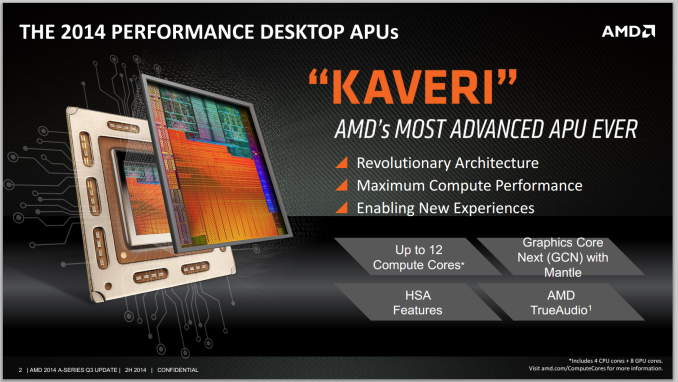
AMD A10-7800 Review: Testing the A10 65W Kaveri
Kaveri was launched as a processor line, on desktop, back in January 2014. At the time we were given information on three of the APUs, the A10-7850K, A10-7700K and A8-7600, and reviewed two of them, including the A8-7600 65W processor. However, at the time, AMD stated that the model we tested was to come out at a later date: that date is today, in a trio of 65W parts. The A10-7800 we are testing today is the locked down version of the A10-7850K, with a slight speed reduction to hit 65W as well as a configurable TDP to 45W.
The Drive to Lower TDP
Previous AMD APU releases have often come with a flurry of processors up and down the price range. Back with the Llano cores and the FM1 platform, two processors were released in the first month followed by six the next and six more by the end of the 2011. With Trinity, it was a similar story: four processors in the first two months, then ten more by the end of the 2012. Richland had eight processors at launch, then other 8 by the end of 2013 and three more for 2014. This is what makes Kaveri a little different: two 95W processors at launch at the start of 2014, and three 65W for July 2014, six months later. Not only is this a large time gap between expanding the processor range, but also a small number of SKUs. That being said, CPU-World lists another 65W APU for release after this trio, and then no more Kaveri until the end of the year when four ‘PRO’ (aka ‘Business Class’) models enter the arena.
Having your mainstream platform headed up by two 95W APUs of the latest generation architecture for so long does nothing for the low power crowd, and AMD’s official reasons for delaying the launch of their 65W parts is due to the lower power message AMD wants to convey, especially in terms of configurable TDP.
Each of the new 65W parts released today has two modes of operation. Out of the box, they will run in 65W mode, using a restricted range of processor frequency in the faster end of operation but with ultimately less efficiency. With an adjustment in the BIOS, they will operate at 45W, which will adjust the base frequency of the processor, relying more on turbo for single threaded workloads. AMD’s numbers above quote a 6-7% dip in performance for a 31% drop in TDP.
If we consider Intel's strategy and AMD's older strategy into the mix, CPU manufacturers would release two processors, one at 45W and one at 65W, in order to offer this difference. That way each die could be tuned for frequency or voltage, as well as processor graphics residency. For whatever reason, AMD decided to consolidate the differing power options, perhaps in order to reduce the number of SKUs on the shelves and make the customer’s choice an easier one.
But therein lies an issue. The number of users prepared to go into the BIOS and adjust the frequency is slim at best, which leads on to system integrators to implement this change in the units they sell. But which system integrators are going to sell products to their customers that do not perform at the maximum performance? It only works when the APU is for a specific design, like an off-the-shelf HTPC or digital signage. The other implementation could be that in order to make the product stack work, it helps to have a few SKUs such that everyone pays more even if they use less – having 45W APUs in the stack might drive sales away from the higher performing models.
The New APUs
AMD’s nomenclature on Compute Cores sums up the number of CPU threads and the number of Compute Units in the processor graphics to give a total number. The previous APUs released were rated at 12 compute cores (A10-7850K) and 10 compute cores (A10-7700K), and the new APUs released today have 12 (A10-7800), 10 (A8-7600) and 6 (A6-7400).
| AMD Kaveri APUs | |||||
| A10-7850K | A10-7800 | A10-7700K | A8-7600 | A6-7400K | |
| TDP | 95W | 65W | 95W | 65W | 65W |
| Compute Cores |
4 CPU + 8 GPU |
4 CPU + 8 GPU |
4 CPU + 6 GPU |
4 CPU + 6 GPU |
2 CPU + 4 GPU |
| Modules / Threads | 2 / 4 | 2 / 4 | 2 / 4 | 2 / 4 | 1 / 2 |
| Base Frequency | 3700 | 3500 | 3400 | 3100 | 3500 |
| Turbo Frequency | 4000 | 3900 | 3800 | 3800 | 3900 |
| L1 Cache |
192 KB I$ 64 KB D$ |
192 KB I$ 64 KB D$ |
192 KB I$ 64 KB D$ |
192 KB I$ 64 KB D$ |
96 KB I$ 32 KB D$ |
| L2 Cache | 4 MB | 4 MB | 4 MB | 4 MB | 1 MB |
| Graphics | R7 | R7 | R7 | R7 | R5 |
| GPU Cores | 512 | 512 | 384 | 384 | 256 |
| GPU Clock | 720 | 720 | 720 | 720 | 756 |
| Max DDR3 | 2133 | 2133 | 2133 | 2133 | 1866 |
| SSRP | $173 | $155 | $155 | $105 | $77 |
One might imagine that AMD would at some point offer APUs at the same frequency with the same name but without the ‘K’ monitor for overclocking, but the distinct numbering difference is occompanied by the respective frequency adjustments. In this case, the A10-7800 is 200 MHz less on the base frequency than the A10-7850K but +100 MHz over the A10-7700K.
AMD confirmed with us after the initial press call the number of streaming processors in the processor graphics, as well as their frequencies. Based on these numbers, the two 78xx APUs have the full complement at 720 MHz, with the 77xx and 76xx reducing down to 6 compute cores. The A6-7400K is interesting in that the frequency is increased to 756 MHz, perhaps indicating that removing one of the CPU modules and half the IGP gives them extra room to play with for frequency. The A6 model does have another metric to set it apart – official memory support is down to DDR3-1866. This differentiation was also present on the Richland 65W A6 and Trinity 65W A6 processors as well.
| AMD 65W Bulldozer Based APUs | ||||||||
| Trinity | Richland | Kaveri | ||||||
| Model |
A6- 5400K |
A8- 5500 |
A10- 5700 |
A8- 6500 |
A10- 6700 |
A10- 7800 |
A8- 7600 |
A6- 7400K |
| Microarchitecture | Piledriver | Steamroller | ||||||
| Socket | FM2 | FM2+ | ||||||
|
Modules / Threads |
1 / 2 | 2 / 4 | 1 / 2 | |||||
| CPU Base Freq | 3600 | 3200 | 3400 | 3500 | 3700 | 3500 | 3100 | 3500 |
| Max Turbo | 3800 | 3700 | 4000 | 4100 | 4300 | 3900 | 3800 | 3900 |
| TDP | 65W | |||||||
| L1 C$ | 64/32 |
128 KB C$ 64 KB D$ |
192 KB C$ 64 KB D$ |
96/32 | ||||
| L2 C$ | 1 MB | 2 x 2 MB | 1 MB | |||||
| Graphics |
HD 7540D |
HD 7560D |
HD 7660D |
HD 8570D |
HD 8670D |
R7 | R7 | R5 |
| GPU Cores | 192 | 256 | 384 | 256 | 384 | 512 | 384 | 256 |
| GPU Clock | 760 | 760 | 760 | 800 | 844 | 720 | 720 | 756 |
| Max DDR3 | 1866 | 1866 | 1866 | 1866 | 1866 | 2133 | 2133 | 1866 |
| Current Price | $60 | $99 | N/A | $119 | N/A | $155 | $105 | $77 |
Kaveri APU Features
In our initial Kaveri coverage and review of the A10-7850K, AMD spent a large amount of time with the press going over their new features for the Kaveri line of APUs. At the time, Mantle support was the big headline, along with HSA (Heterogeneuous System Architecture) that afforded several compute features which could accelerate certain workloads.
Rahul’s deep dive on HSA is well worth a read, beyond my simple coverage here. The main principles allow the processor threads and integrated graphics to both access the same areas of DRAM (known as a Unified Memory Architecture) without expensive memory copies and maintaining the data structure.
With heterogeneous queuing, both the CPU threads and integrated graphics can generate extra work for the other, allowing for dynamic asynchronous compute.
These features, along with working with software developers to optimize their workflow, allow AMD to quote improvements. In our PR pack with this launch AMD is quoting up to 69% faster upscaling in Adobe Photoshop CC for A10 vs. i5, up to 7x faster in LibreOffice for A8 vs. i3, and up to 65% faster JPEG decoding time on A6 vs. Pentium.
For gaming, alongside Mantle support due to the use of GCN, AMD has also implemented the TrueAudio DSP on the Kaveri APU line. Rather than use CPU power or shaders for complex directional audio affects, the DSP is designed to speed these up and reduce stress on other components of the system for better frame rates. The two games being quoted for TrueAudio are Thief and Lichdom Battlemage.
The other feature using the GCN cores is HEVC Compute support with PowerDVD 14, using OpenCL to speed up decoding for high definition content. With a soon-to-be released update, AMD Fluid Motion Video should also be supported.
Launch Deal
With the launch of the 65W APUs, AMD is going to run a promotion for any user purchasing an A10 between August and October – purchase an A10 APU and have a choice of a free game between Thief, Sniper Elite III and Murdered Soul Suspect.
Test Setup
As these APUs are still part of the Kaveri line, they should work with any FM2+ motherboard, although depending on the motherboard manufacturer it may require a BIOS update. We suggest that you contact the retailer to ensure that the motherboard BIOS is up to date and compatible with the new APU.
| Test Setup | |
| Processor |
AMD A10-7800 2 Modules, 4 Threads |
| Motherboards | MSI A88X-G45 Gaming |
| Cooling |
Corsair H80i Thermalright TRUE Copper |
| Power Supply | OCZ 1250W Gold ZX Series |
| Memory | 2 x Corsair Vengeance Pro 2x8 GB DDR3-2400 10-12-12 Kit |
| Memory Settings | 2133 8-9-9 |
| Video Cards | MSI GTX 770 Lightning 2GB (1150/1202 Boost) |
| Video Drivers |
Catalyst 14.3 NVIDIA Drivers 337 |
| Hard Drive | OCZ Vertex 3 256GB |
| Optical Drive | LG GH22NS50 |
| Case | Open Test Bed |
| Operating System | Windows 7 64-bit SP1 |
| USB 2/3 Testing | OCZ Vertex 3 240GB with SATA->USB Adaptor |
| WiFi Testing | D-Link DIR-865L 802.11ac Dual Band Router |


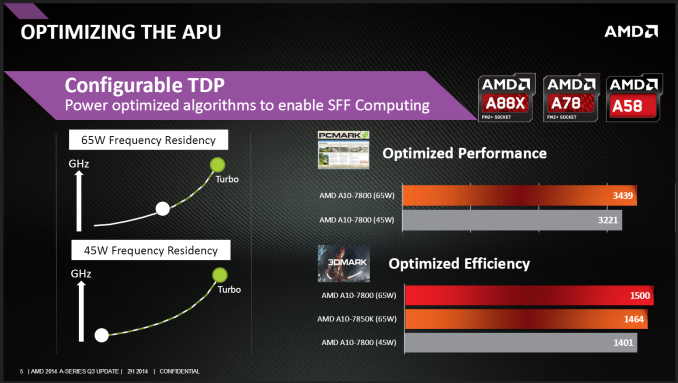
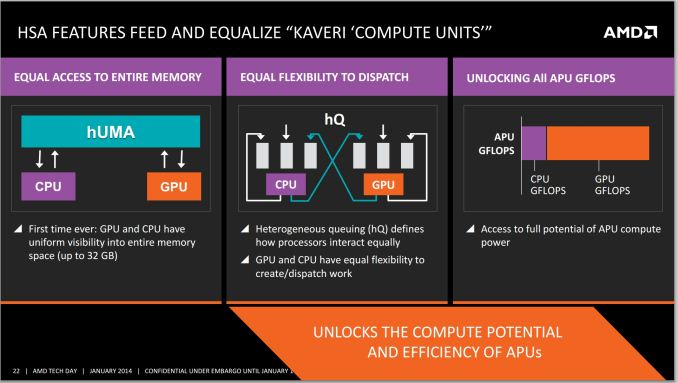
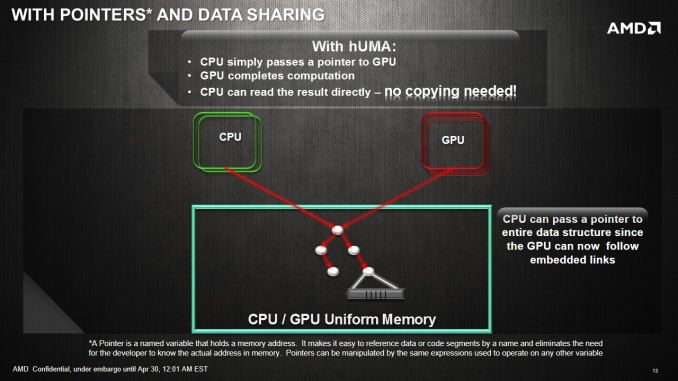
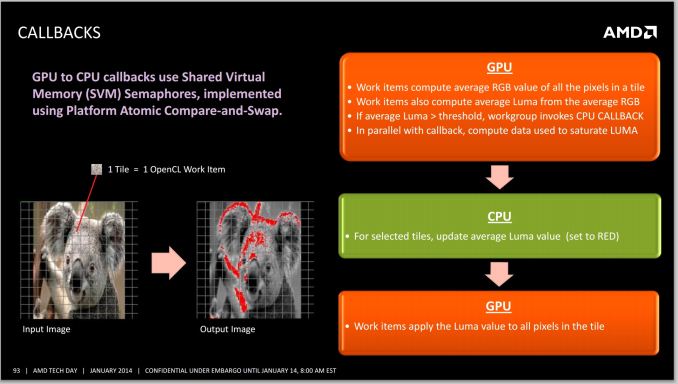






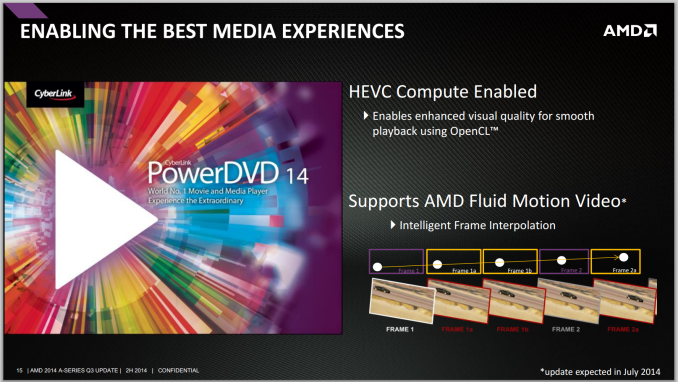









147 Comments
View All Comments
tomsworkshop - Thursday, July 31, 2014 - link
the 25% extra cost u paid only give u 2.5% performance increase in realityGuspaz - Friday, August 1, 2014 - link
Depends on what you're doing. Want to encode a video? Then the 25% extra cost will cut render times in half (or better).bigboxes - Sunday, August 3, 2014 - link
Seriously, WTF? People that are encoding are not going to buy an APU. Stop with the fanboi nonsense. I have a quad core i7 processor in my main rig. I do whatever I want. However, I don't give a crap about gaming so I just have an $200 card just so I could do whatever I wanted without the machine hiccuping.My wife doesn't encode, game, video edit or just about anything cpu intensive. So I got her an AMD APU recently after Athlon 64 X2 finally crapped out. Paired with a SSD and 8gb of ram it flies for her all important tasks of surfing the internet, typing Word documents, streaming Hulu/YouTube videos and the occasional online survey. Tell me why she needs a Pentium/i3/i5 or whatever super premium cpu you nerds can come up with? Tell me how she would even notice the difference? She doesn't even know what WinRAR is let alone understand how she could save a couple of seconds in packing/unpacking such a file. Yeah, it could be such a bitchin' machine if only... duh. All I care about is reliable and quick for her purposes. She'll be able to do anything she wants to do and it will breeze through any of those tasks. We had the internet go down yesterday and she couldn't figure out how to unplug the cable modem for the Time Warner rep and you're worried that she will take too long to convert her videos? Face it. She waits for me to come home and do it all for her. Of course, she sounds like a techie when it comes to her mother. Yeah, there's no place for an AMD apu. </sarcasm>
Guspaz - Sunday, August 3, 2014 - link
Wowzers, you're really missing the point. You think people don't need the cost/performance of the i5, which offers 100%+ more performance for 25% more money? Fine, that's a perfectly valid argument.Except the i3-4330 included in this very review was significantly faster than the a10-7800, used less power... and costs at least $15 less.
In terms of accusing me of "fanboi nonsense", I've owned multiple AMD processors, and multiple AMD GPUs, stretching all the way back to the K6-2. But their current CPU product lineup is simply not competitive, except possibly at the very low end... and the a10-7800 is *NOT* at the very low end. It gets outperformed by cheaper and cooler Intel processors.
bigboxes - Sunday, August 3, 2014 - link
I forgot she checks her email too. She desperately needs more processing power. :eyeroll: I think I'll stick with the superior on board video. Thanks.Andrew Lin - Tuesday, August 5, 2014 - link
sounds to me like she doesn't even need the integrated GPU either. the integrated graphics of and core i3 sound more than suited to what you're wife is doing, from the sound of it. so what is she using the "superior on board video" of the more power hungry amd apu for again?bigboxes - Tuesday, August 5, 2014 - link
Look, I buy Intel chips for my high end rig. I use the horsepower. The price difference is negligible between the competing processors. The power usage doesn't matter to me in the slightest. To me the Kaveri will be sipping on the juice. I keep my boxes on 24/7 and I just don't have that high of an electrical bill. I only have my wife turn off her pc at night because of the fan controller's bright blue lights (her pc in in our bedroom). My wife likes to stream shows from the computer to an HD television while surfing the net on her monitor. I figure the extra headroom on the AMD APU would drive that without issue. Whatever the case, I just don't think the purchase is a waste like many are making it out to be.eanazag - Thursday, July 31, 2014 - link
Where's the 45W performance numbers?Where's the power consumption numbers in 65W and 45W?
How well does it work in the low power mode? Is there not speculation that it took so long because there were issues with the product?
What are the clocks in 45W mode?
Most of the commenters below are remarking about dGPUs, Crossfire, and budget PCs.
johnny_boy - Friday, August 1, 2014 - link
Check out Anand's review. You want someone to reproduce it in full here in the comments?johnny_boy - Friday, August 1, 2014 - link
The price difference is significant. If you add a "decent" GPU then plan to spend around $200-300 more (including taxes) than the AMD system. That covers the costier i5 and a half-decent GPU like an R9 270.